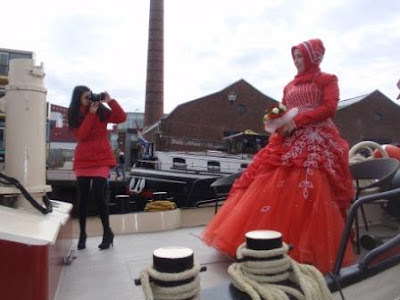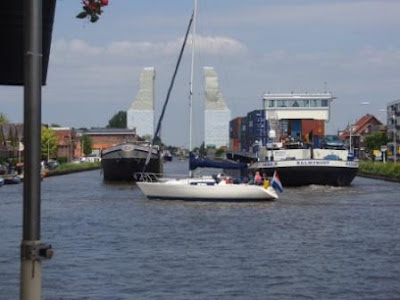We can offer a round trip for the beginning of
September, going through the beautiful and impressive ships elevators and the
Inclined Plane of Ronquières.
We can offer a special deal and if you care to
find out more just follow this link
Although
summer has formally been there since my previous blog we, like most of us,
haven’t noticed it until recently.
This blog’s
entry is characterised by the huge amounts of water that have come down.
It has
resulted in extremely high water levels and fast currents, faster than usual.
Upon
leaving Astene we did not go down the Leie
River to Ghent. More’s the pity as I had been looking
forward to that but I had to take a rain check, we went down the
Afleidingskanaal instead.
The Leie is
a narrow, twisting river, hard to manoeuvre and even more so when going
downstream where you cannot control your speed completely.
And
besides, the water levels in the Leie can rise very quickly, a few meters
within 24 hours which makes it a broader river, but hard to know where there
are shallow parts.
Not the
right choice for us this time.
Once we
reached the Scheldt
River we found the
current to be very fast there as well, going downstream with low-tide. There
was more water than usual, but the river is very wide so there was no real
problem. Just watch out and stay alert.
 |
| bank on the Scheldt
at low tide
|
When we
went upstream on our way up we went with high-tide, now the water was going
down. This alters the picture completely, wide mud banks with lots of birds
searching for worms instead of a wide river where the banks are shallow.
When I
think about the effects of high or low tides I can figure it out, and yet it’s
different when it is clearly visible.
At
Dendermonde we left the Scheldt and entered
the Dender river.
 |
statue of the horse Bayard carrying the four
children, on the tower in Dendermonde
|
Here also
there were higher water levels and faster currents than usual but – going
upstream – it bothered us less, though sometimes navigating was not that easy.
We passed a tjalk about our size – going downstream – who really was scraping
the banks.
Michel likes
this, he is doing it well and he likes a bit of a challenge.
We intent
to go down the Dender on our way back, provided it doesn’t rain as heavily.
At
Geraardsbergen we were even advised to wait for a few hours before leaving
because of the heavy current.
When water
levels at the canals and rivers that join the Dender are getting too high they
open the sluices and let the water into the Dender which then suddenly rises
heavily.
No real
problem, there was plenty to look at in Geraardsbergen.
Like in every
town and village in Belgium
there was a track laid out for cycling in the weekend.
We had
already noticed that the Belgians cycle in herds, very fast, not really taking
heed of their fellow road-users and quite fanatically.
Lots of,
not cycling, Belgians complain about it, too.
 |
| a (small) herd |
But in
Geraardsbergen it was special, because there is the Wall, even ignoramuses like
us are familiar with the Wall, that was taken out of the yearly Flanders Cycle
Tour as of this year!
We have
seen the cyclists coming down, slithering and sliding through the mud and then
going up on the cobblestones.
Next day we
came back for another look and we could walk there and now we understand why
these stones are called “kuitenbijters” (calve-snappers).
 |
| slithering down and than a sharp turn left to mount over the cobblestones |
After
Geraardsbergen cruising became easier because there the Dender is canalised and
after Ath it is a proper canal.
In Lessines
we visited the Hôpital Notre Dame à la Rose.
This museum provides an overview of eight centuries of health
care. Beautiful building, a nice and informative exhibition and an astonishing
herbal garden, over 120 kinds of medical plants and a special cellar for
storing ice.
 |
| the former hospital and herbal garden |
Well worth
a visit when in the area.
What would
have been out of the question in Holland
was Panache being allowed inside and doing the tour (not showing any interest,
but even so). He only wasn’t allowed to walk in rooms where there were 17th
century wooden floors (parquet). So our guide carried a little stool for Michel
to sit on with Panache on his lap, now that’s service to you!
The whole
of the track from Dendermonde to Blaton was very green, rural, nice little
towns and villages, especially the part from Ath.
 |
stair of some locks in the canal Blaton-Ath,
in the back the bridge in the E42 (a different universe from the one we’re moving in)
|
We moored
for the night at the huge, completely unused, lock of Pommeroeul where we had
spent a whole week last year.
After that
we took the Grand Ascenseur (a really grand elevator) at Strépy, going up, just
as impressive as going down last year see here for the blog on Pommeroeul and the elevators from last year
and here for our SPECIAL OFFER for cruising the elevators in
September).
 |
| view from the Grand Ascenseur Strépy, between the rows of trees the de Ancienne Branche |
The Brussels Charleroi Canal
turned out to be a beautiful stretch, a pleasant surprise for both of us as –
we don’t know why – we both were under the impression that is was gray and
industrial, on the contrary!
 |
| the friendly Brussels Charleroi Canal |
Just before
Charleroi it
was a bit more industrial, but the real surprise was just after turning on the
Sambre river.
It is
bordered by a big collection of old, partially tumbling down partly still functioning,
industrial glory from the past.
It is
absolutely clear that once they were prospering factories, but there is not a
lot of activity any more.
It is a
very special stretch to cruise, so ugly that it’s beautiful in its own right
and surprising to find it still there (unheard of in Holland).
 |
| the almost deserted and very run down industrial part on the Sambre banks |
We now have
moved a bit up the Sambre, lovely and green and in a few days we’ll cross the
border to France a fortnight
sniffing at “la Douce France” before heading North
again and going to Holland,
taking many detours.
PS: we
postponed the decision on solar panels till we’re back in the Netherlands, so more about that in
the first blog next year









































